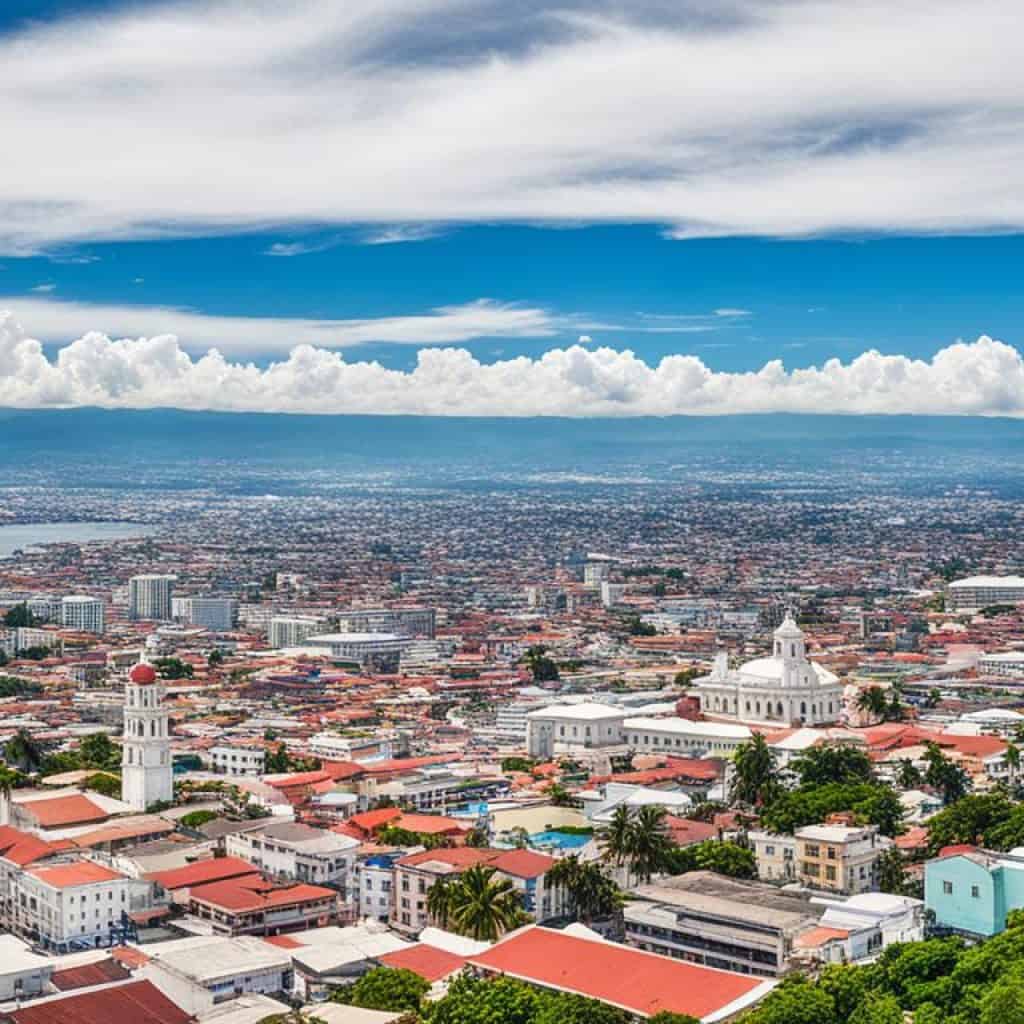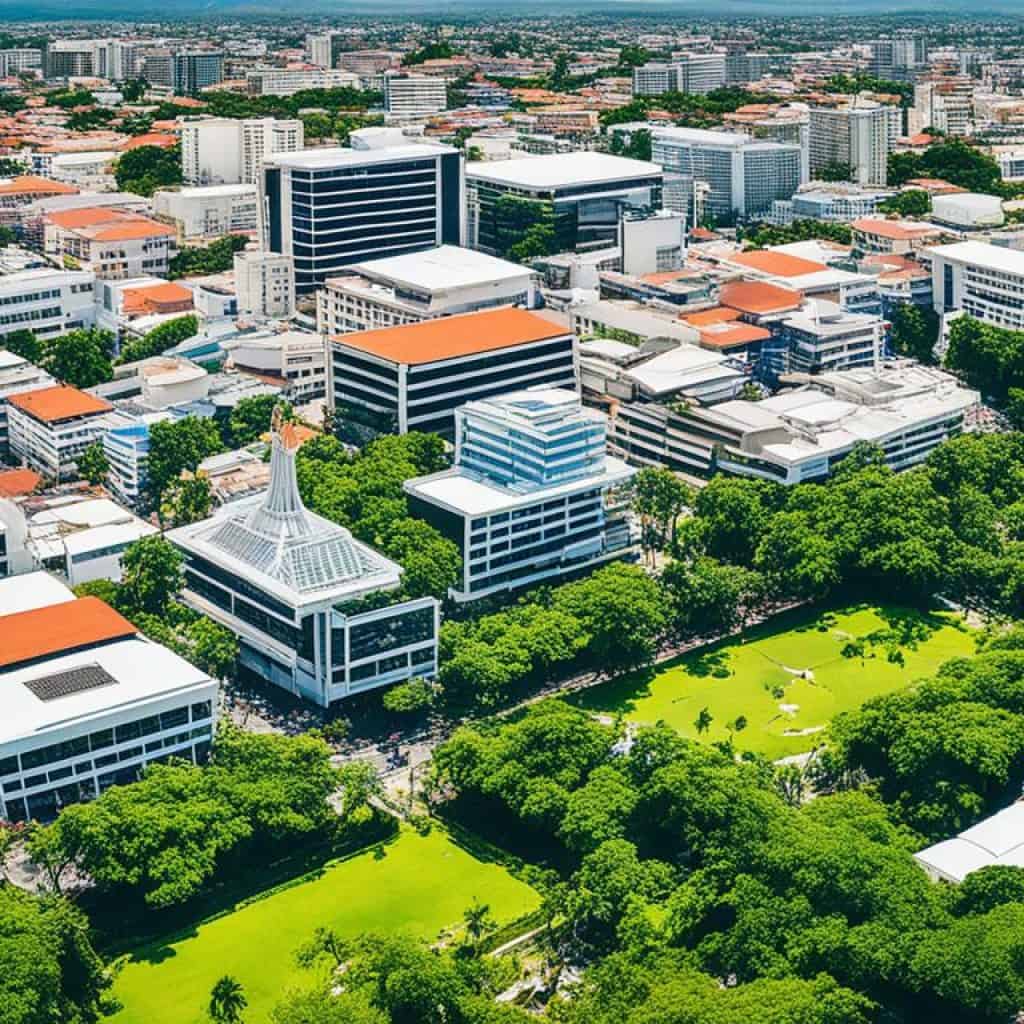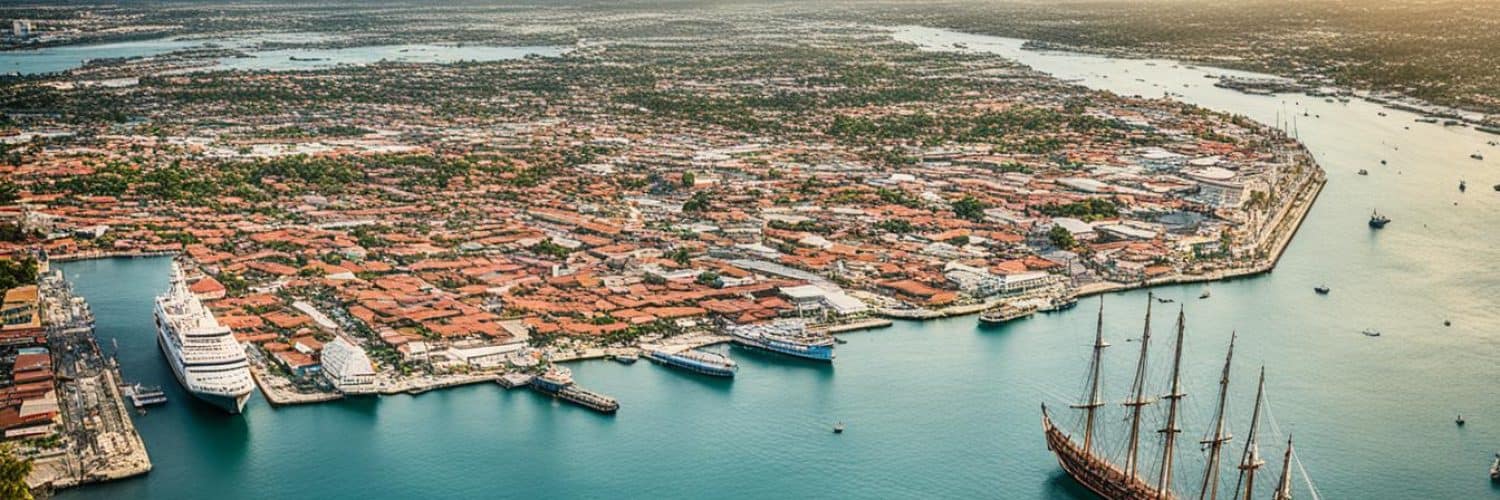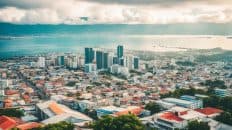Have you ever wondered how the vibrant island of Cebu came to be? Its history is interwoven with a tapestry of events, landmarks, and cultural traditions that have shaped its unique identity. From important dates that mark significant milestones to historical sites that serve as witnesses to the past, Cebu’s rich history offers a fascinating glimpse into its deep historical significance.
Key Takeaways:
- Cebu’s history is a vibrant tapestry of events, landmarks, and cultural traditions.
- Important dates have played a significant role in shaping Cebu’s development.
- Historical sites and landmarks offer a deeper understanding of Cebu’s rich history.
- Cebu’s history holds a special place in the Philippines’ historical narrative.
- By exploring Cebu’s history, visitors can truly appreciate its cultural heritage.
The Yap Sandiego Ancestral House: A Living Testament to Cebu’s History
The Yap Sandiego Ancestral House stands as a living testament to the rich history and cultural heritage of Cebu. Built in the late 17th century, this historic house showcases a blend of Chinese, Filipino, and Spanish architectural influences, reflecting the diverse cultural tapestry of the city.
Stepping inside the Yap Sandiego Ancestral House is like stepping back in time. The meticulously preserved artifacts, antique furniture, and religious relics offer a captivating journey into Cebu’s past. Each item tells a story, providing insights into the lives of the generations that lived within these walls.
The Yap Sandiego Ancestral House is not just a building; it’s a living museum that encapsulates the essence of Cebu’s history and the resilience of its people.
This historical site is a treasure trove of cultural heritage. The ancestral house serves as a window into the daily lives, customs, and traditions of the Cebuanos during different periods of history. From the intricate woodwork and delicate porcelain to the religious statues and family portraits, every item holds significance and contributes to the narrative of Cebu’s history.
The Yap Sandiego Ancestral House is more than just a tourist attraction; it is a symbol of the deep-rooted connection between the past and the present. It serves as a reminder of the endurance and adaptability of the Cebuanos, who have embraced various cultural influences while preserving their unique identity.
Experience the charm of the Yap Sandiego Ancestral House and immerse yourself in Cebu’s fascinating history. Step back in time as you walk through its halls and gain a deeper appreciation for the cultural heritage that is woven into the fabric of this vibrant city.
Experience the Yap Sandiego Ancestral House
Visiting the Yap Sandiego Ancestral House is a truly immersive experience. Take a guided tour of the house and explore its various rooms, each offering a glimpse into a different era of Cebu’s history. Marvel at the intricately carved furniture, admire the collection of antique ceramics, and learn about the legends and stories associated with the house.
The Yap Sandiego Ancestral House is open to the public, and knowledgeable guides are available to provide insights and answer any questions you may have. Whether you are a history enthusiast, a cultural explorer, or simply seeking a unique experience, a visit to this historical site is a must.
| Visiting Information | Contact Information |
|---|---|
| Location: Mabini St., Parian, Cebu City | Phone: +63 32 514 3002 |
| Operating Hours: 9:00 AM – 7:00 PM (Monday to Sunday) | Email: in**@***********************se.com |
| Admission Fee: | Website: www.yapsandiegoancestralhouse.com |
|
Cebu’s Colonial Era: A Melding of Cultures
The colonial era in Cebu’s history left an indelible mark, shaping the city’s cultural landscape through a melding of diverse influences. This period was characterized by the profound Spanish influence in Cebu, which can still be witnessed today in its architecture, traditions, and way of life.
The Spanish brought their distinct architectural style to Cebu, resulting in the construction of impressive colonial buildings and landmarks that still stand as testaments to the past. The iconic Basilica Minore del Santo Niño, built in the 16th century, stands as one of the oldest churches in the Philippines and exemplifies the Spanish influence in Cebu’s religious architecture. Its ornate details and magnificent facade are a blend of European and indigenous design elements, reflecting the cultural fusion that occurred during the colonial era.
This cultural fusion extended beyond architecture and deeply influenced Cebuano traditions and way of life. The Spanish introduced Catholicism to the Philippines, and Cebu embraced the new religion fervently. Today, the Catholic faith remains a significant aspect of Cebuano culture, with religious festivals and practices playing a prominent role in the community.
“The colonial era in Cebu was a transformative period that saw the fusion of Spanish and indigenous cultures, resulting in a unique and vibrant cultural tapestry.” – Dr. Maria Santos, Cebu Historian
The colonial era also brought about a blending of culinary traditions. Spanish cuisine mixed with the local flavors and ingredients, giving rise to delectable dishes that are still enjoyed today. One such famous dish is the lechon, a succulent roasted pig that showcases the culinary expertise born from this cultural fusion.
The influence of the Spanish colonial era can be felt in every facet of Cebuano life, from language and customs to art and music. It embodies the resilience and adaptability of the Cebuano people, who embraced the new while preserving their own cultural heritage. It is a testament to the enduring impact of the colonial era on Cebu’s cultural identity.
Spanish Influence in Cebu’s Architecture
The Spanish colonial era left an architectural legacy in Cebu that is both awe-inspiring and historically significant. The fusion of Spanish and local architectural styles resulted in unique structures that still stand as reminders of the city’s past.
| Historical Landmark | Architectural Style |
|---|---|
| Basilica Minore del Santo Niño | Baroque and Neoclassical |
| Fort San Pedro | Spanish Military Architecture |
| Casa Gorordo Museum | Spanish-Filipino Bahay na Bato |
These architectural marvels serve as cherished reminders of Cebu’s colonial past and offer visitors a glimpse into the rich history that shaped the city’s cultural landscape. Exploring these landmarks is like stepping back in time and experiencing the fusion of cultures that occurred during the colonial era.
Cebu’s Important Historical Dates
Cebu, with its rich history and cultural heritage, boasts numerous important historical dates that have significantly shaped its development. These milestone events reflect the city’s enduring legacy. Let’s delve into some of the most significant dates in Cebu’s history:
The Arrival of Ferdinand Magellan in 1521
In 1521, Ferdinand Magellan’s arrival in Cebu marked a pivotal moment in Philippine history. This event not only introduced Christianity to the archipelago but also sparked a series of transformative events that would forever change the course of the nation’s development.
The Battle of Mactan
In the same year as Magellan’s arrival, the Battle of Mactan took place. This historic battle witnessed the bravery and strategic leadership of the Cebuano chieftain Lapu-Lapu, who successfully resisted Magellan’s forces. This victorious stand against colonial rule is celebrated as a symbol of Filipino courage and resistance.
The Establishment of Cebu as the First Spanish Settlement in the Philippines in 1565
In 1565, Miguel Lopez de Legazpi, together with Augustinian friars, established the first Spanish settlement in the Philippines, specifically in Cebu. This marked the beginning of Spanish colonization and the subsequent heavy influence on Cebu’s culture, architecture, and governance.
Declaration of Cebu City as a Chartered City in 1937
In 1937, Cebu City was officially recognized as a chartered city, solidifying its status and importance as a key urban center in the Philippines. This declaration further paved the way for the city’s growth and development into the bustling metropolis it is today.
These important historical dates showcase the significant events and milestones that have shaped Cebu’s unique identity. From the introduction of Christianity and the triumph of local heroes to the establishment of Spanish rule and the city’s modern development, Cebu’s history is a testament to its enduring cultural and historical significance.
| Event | Year |
|---|---|
| The Arrival of Ferdinand Magellan | 1521 |
| The Battle of Mactan | 1521 |
| Establishment of Cebu as the First Spanish Settlement | 1565 |
| Declaration of Cebu City as a Chartered City | 1937 |
Exploring Cebu’s Historical Landmarks
Cebu, known for its rich history, is home to several remarkable historical landmarks that provide a deeper understanding of its cultural heritage. These landmarks not only offer a glimpse into the past but also serve as significant symbols of Cebu’s historical and religious significance.

Basilica Minore del Santo Niño
One of the oldest churches in the Philippines, the Basilica Minore del Santo Niño, stands as a testament to Cebu’s strong religious heritage. Built in the 16th century, this grand church houses the revered Santo Niño, a statue depicting the child Jesus. The Basilica is a pilgrimage site and attracts both locals and tourists with its vibrant festivals like the Sinulog, celebrating the Santo Niño.
Fort San Pedro
Located in the heart of Cebu City, Fort San Pedro is a Spanish fortress that dates back to the 16th century. This well-preserved structure showcases the city’s colonial past and is a reminder of the Spanish influence in Cebu. Visitors can explore the fort’s intricate design, walk along its walls, and learn about its historical significance through informative exhibits and displays.
Taoist Temple
The Taoist Temple, perched atop a hill in Beverly Hills, offers a serene escape and a glimpse into Cebu’s Chinese heritage. Inspired by the architecture of mainland China, this colorful temple is adorned with intricate carvings, dragon statues, and vibrant decorations. Visitors can climb its 81 steps and marvel at the panoramic views of the city while immersing themselves in the Taoist traditions and rituals.
Magellan’s Cross
Magellan’s Cross, located within a chapel near the Basilica Minore del Santo Niño, is a symbol of Cebu’s historical and religious importance. Planted by Ferdinand Magellan in 1521 upon his arrival in Cebu, the cross marks the introduction of Christianity to the Philippines. This iconic landmark attracts visitors who seek to witness this historical relic and pay homage to Cebu’s significant role in the spread of Christianity in the country.
Heritage of Cebu Monument
The Heritage of Cebu Monument, located at Parian District in Cebu City, celebrates the city’s rich history through a stunning sculpture ensemble. Created by local artist Eduardo Castrillo, this monument depicts significant events and historical figures that have shaped Cebu’s identity. The intricate details and captivating storytelling make it a must-visit attraction for history enthusiasts and art lovers alike.
Exploring these famous landmarks in Cebu is a must for anyone seeking to connect with the city’s vibrant history and cultural heritage. Whether it’s the religious significance of the Basilica Minore del Santo Niño, the colonial charm of Fort San Pedro, or the cultural fusion showcased at the Taoist Temple, each landmark offers a unique peek into Cebu’s past. Visiting these must-visit historical sites in Cebu will undoubtedly leave you with a deeper appreciation for the city’s rich and diverse historical tapestry.
The Cultural Significance of Cebu’s Festivals
Cebu is renowned for its vibrant festivals that celebrate its cultural heritage. These festivals not only showcase the diverse traditions and customs of the Cebuanos but also serve as a testament to their deep-rooted connection to their history and culture. Among the various festivals held in Cebu, the Sinulog Festival stands out as one of the most famous and highly anticipated events in the Philippines.
The Sinulog Festival, held annually on the third Sunday of January, pays tribute to the Santo Niño or the Child Jesus. It is a grand celebration filled with vibrant parades, street dances, and religious processions. The highlight of the festival is the Sinulog Grand Parade, where participants clad in colorful costumes dance to the beat of drums, trumpets, and traditional songs.
The festival attracts both locals and tourists from all over the world who come to witness this spectacular event. It is a time of unity and joy as people gather to honor their faith, express their gratitude, and celebrate their cultural heritage. The Sinulog Festival is truly a sight to behold, a testament to the rich and lively spirit of the Cebuanos.
Aside from the Sinulog Festival, Cebu is also home to other notable cultural celebrations. The Kadaugan sa Mactan, or the Victory in Mactan, commemorates the bravery of Lapu-Lapu, a local chieftain who defeated Ferdinand Magellan in the Battle of Mactan. This festival brings history to life through reenactments, parades, and various activities that highlight the significance of this historic event.
The Pahina Festival is another cultural celebration in Cebu that showcases the city’s history and traditions. It is a week-long festival that features exhibitions, art shows, cultural performances, and culinary events. Through this festival, Cebuanos take pride in their cultural heritage and share it with visitors, ensuring the preservation and continuation of their traditions.
The cultural significance of Cebu’s festivals goes beyond entertainment and merriment. These celebrations serve as a vital link to the past, reminding the people of Cebu of their roots and the values that define their identity. They strengthen the sense of community, foster pride in their cultural heritage, and provide opportunities for cultural exchange and understanding.
Experience the Festivals of Cebu
To truly immerse yourself in the vibrant cultural celebrations in Cebu, make sure to plan your visit during these festivals. Witness the awe-inspiring grandeur of the Sinulog Festival as the streets come alive with colorful costumes, rhythmic dances, and infectious energy. Immerse yourself in the historical reenactments of the Kadaugan sa Mactan and gain a deeper understanding of the courageous spirit of Lapu-Lapu and his victory. And don’t miss the Pahina Festival, where you can experience the rich history of Cebu through various cultural activities and performances.
Cebu’s festivals are not just events; they are opportunities to connect with the vibrant culture and traditions of the Cebuanos. Come and be part of these celebrations, create lasting memories, and deepen your appreciation for the cultural diversity and historical significance of Cebu.
Cebu’s Contribution to Philippine Independence
Cebu played a significant role in the Philippine fight for independence, with brave Cebuanos standing at the forefront of the revolution. Among these esteemed heroes were Pantaleon Villegas, known as Leon Kilat, and Sergio Osmena Sr., both instrumental in the struggle against Spanish and American colonization. Their unwavering dedication to the cause and strong leadership paved the way for the nation’s freedom.
Leon Kilat emerged as a key figure during the Philippine Revolution. He led a successful uprising in Cebu against Spanish rule, making him a revered figure in the city’s history. His fearless fighting spirit and strategic prowess inspired others to join the revolution and fight against the oppressive colonial forces.
Leon Kilat’s indomitable spirit and determination to liberate Cebu from Spanish oppression continue to inspire generations of Filipinos. His unwavering commitment to the cause of Philippine independence remains a testament to the resilience and courage of the Cebuanos.
Another influential Cebuano leader, Sergio Osmena Sr., played a pivotal role in shaping the nation’s political landscape. He served as the first Visayan President of the Philippine Commonwealth Government, advocating for Philippine independence from American rule. Osmena’s leadership and diplomacy skills were instrumental in securing the eventual independence of the Philippines in 1946.
Today, the heroic contributions of Cebuano revolutionaries like Leon Kilat and Sergio Osmena Sr. are remembered and celebrated. Their courage, sacrifice, and unwavering dedication to the fight for independence are part of Cebu’s proud history and serve as a constant reminder of the resilience and determination of the Filipino people.
Cebuano Heroes in Action
| Hero | Contribution |
|---|---|
| Pantaleon Villegas (Leon Kilat) | Led successful uprisings against Spanish rule in Cebu |
| Sergio Osmena Sr. | Advocated for Philippine independence from American rule |
Through their unwavering spirit and selfless acts, Cebuano heroes like Leon Kilat and Sergio Osmena Sr. played an integral role in the struggle for Philippine independence. Their contributions to the nation’s history and their commitment to freedom continue to be celebrated, ensuring that their legacies will never be forgotten.
Next, we delve into the rich cultural and historical significance of Cebuano cuisine, exploring the flavors and traditions that make it truly unique.
The Cultural and Historical Significance of Cebuano Cuisine
Cebuano cuisine is a delightful reflection of the island’s rich cultural and historical heritage. The diverse flavors, unique cooking techniques, and traditional dishes embody the culinary legacy passed down through generations.
One iconic dish that encapsulates the culinary expertise of the Cebuanos is lechon, a mouthwatering roasted pig. The preparation of lechon is a culinary art form, requiring meticulous attention to detail and hours of slow cooking over an open fire. The result is succulent, flavorful meat with perfectly crispy skin, making it a must-try delicacy and a centerpiece in festive gatherings.
Aside from lechon, Cebuano cuisine boasts an array of traditional dishes that showcase the island’s gastronomic heritage. Kinilaw, a refreshing dish similar to ceviche, features raw fish or seafood marinated in vinegar and spices, giving it a tangy and savory flavor. The puso, or hanging rice, is a unique and practical way of cooking rice. Wrapped in woven coconut leaves, the rice is steamed, creating a compact and easy-to-eat package perfect for a meal on the go or a picnic. Meanwhile, sutukil combines three different cooking methods – grilling, boiling, and stewing – to create a delectable medley of seafood flavors.
Cebuano cuisine not only tantalizes the taste buds but also serves as a gateway to understanding the island’s rich cultural heritage. Each dish tells a story of tradition, resilience, and culinary innovation, making Cebuano cuisine an essential part of the region’s cultural tapestry.
The Culinary Heritage of Cebu
“Cebuano cuisine is more than just a collection of dishes – it is a living testament to the island’s history, culture, and the resilience of its people.” – Maria Lourdes, Cebu Local
The history of Cebuano cuisine is intertwined with the island’s historical milestones and cultural fusion. Influenced by Spanish, Chinese, and indigenous flavors, Cebuano dishes represent the diversity and cultural blend of the region.
Each bite of Cebuano cuisine carries the essence of the island’s traditions and the culinary expertise passed down for centuries. Exploring the local food scene allows visitors to immerse themselves in the unique flavors and stories embedded in every dish.
A Taste of the Past: How Cebuano Cuisine Preserves History
Through Cebuano cuisine, one can take a culinary journey back in time, experiencing the flavors that have shaped the region’s history. The fusion of different cooking techniques and ingredients reflects the historical encounters and exchanges that have taken place in the region.
The culinary heritage of Cebu is kept alive through restaurants, food festivals, and street vendors that proudly showcase traditional Cebuano dishes. These culinary establishments serve as a bridge between the past and the present, preserving and celebrating the island’s vibrant food culture.
By savoring the unique flavors of Cebuano cuisine, visitors can gain a deeper appreciation for the island’s culinary heritage and the cultural richness it represents.
| Cebuano Dish | Description |
|---|---|
| Lechon | A roasted pig dish with tender meat and crispy skin, considered a delicacy in Cebu. |
| Kinilaw | A tangy and refreshing dish made with raw fish or seafood marinated in vinegar and spices. |
| Puso | Hanging rice wrapped in coconut leaves, steamed to create a compact and portable rice package. |
| Sutukil | A combination of grilling, boiling, and stewing seafood, resulting in a flavorful medley of flavors. |
Cebu’s Museums: Guardians of History
Cebu is home to several museums that play a crucial role in preserving and showcasing the city’s history. Among these museums, Museo Sugbo and the Cebu Provincial Museum stand out for their extensive collections of artifacts, artworks, and historical items that provide visitors with a comprehensive understanding of Cebu’s past.

Museo Sugbo, situated in an old Spanish-era jail, is a fascinating repository of Cebu’s historical treasures. It features exhibits that trace the city’s evolution from pre-Spanish times to the present. From antique furniture and religious artifacts to ancient pottery and archaeological relics, Museo Sugbo offers a captivating journey through the annals of Cebu’s history.
The Cebu Provincial Museum, on the other hand, showcases diverse aspects of Cebuano heritage. Its collections include artifacts from different historical periods, classic Cebuano paintings, and traditional crafts. The museum offers a unique opportunity to delve into the rich cultural tapestry of the province and witness its artistic and historical heritage firsthand.
“These museums serve as guardians of history, ensuring that future generations can learn and appreciate Cebu’s cultural heritage.”
By preserving and sharing the stories of Cebu’s past, these museums not only educate visitors but also foster a deep sense of pride among Cebuanos. They contribute to the preservation and celebration of the city’s cultural identity, serving as invaluable resources for researchers, students, and anyone interested in exploring Cebu’s remarkable history.
Museo Sugbo
| Location | Provincial Capitol Compound, Cebu City |
|---|---|
| Opening Hours | Tuesdays to Saturdays: 9:00 AM – 6:00 PM |
| Admission | Adults: $2 Students/Senior Citizens: $1 Children (7 years old and below): Free |
Cebu Provincial Museum
| Location | Osmena Boulevard, Cebu City |
|---|---|
| Opening Hours | Tuesdays to Sundays: 10:00 AM – 5:30 PM |
| Admission | Adults: $3 Students/Senior Citizens: $2 Children (5 years old and below): Free |
Visiting these museums is an enriching experience that allows you to connect with Cebu’s history and immerse yourself in its vibrant cultural heritage. Whether you’re a history enthusiast, an art lover, or simply curious about the city’s past, Museo Sugbo and the Cebu Provincial Museum are must-visit destinations that offer a glimpse into the captivating story of Cebu.
Cebu’s Historical Importance in the Philippines
Cebu, known as the cultural capital of the Philippines, holds immense historical importance in shaping the nation’s identity. As the first Spanish settlement and the birthplace of Christianity in the country, Cebu played a pivotal role in laying the foundations of Philippine history and culture.
“Cebu, the oldest city in the Philippines, has been an important center for trade and commerce since ancient times.” – Historical Society of the Philippines
Cebu’s historical significance is evident through its rich cultural heritage and iconic landmarks that stand as reminders of its past. The city’s historical sites, such as the Yap Sandiego Ancestral House and the Basilica Minore del Santo Niño, offer glimpses into Cebu’s diverse history and the blending of different cultures over the centuries.
The Spanish influence is particularly prominent in Cebu, with colonial-era architecture and traditions still visible today. The presence of historical landmarks like Fort San Pedro and Magellan’s Cross attest to the enduring impact of Spanish colonization on the city.
It is also worth noting that Cebu has been the birthplace of numerous Filipino heroes who fought for Philippine independence. Notable figures such as Pantaleon Villegas, better known as Leon Kilat, and Sergio Osmena Sr. played crucial roles in the Philippine revolution against Spanish and American colonization.
The Birthplace of Festivals
Cebu’s cultural significance extends beyond its history to its vibrant festivals that celebrate the city’s traditions and heritage. The world-renowned Sinulog Festival, held annually in January, showcases the devotion of Cebuanos to the Santo Niño and serves as a testament to the deep-rooted religious and cultural practices of the city.
Other festivals like the Kadaugan sa Mactan and the Pahina Festival highlight significant historical events and promote Cebu’s local history and traditions.
Image
Visiting Cebu allows travelers to immerse themselves in the historical importance of the city and experience its cultural capital. From exploring historical landmarks to participating in vibrant festivals, Cebu offers a unique opportunity to connect with the rich heritage of the Philippines.
“Cebu’s historical significance and cultural vibrancy make it a must-visit destination for history enthusiasts and those looking to delve deep into the roots of the Philippines.” – Travel and Leisure Magazine
Cebu’s Historical Evolution: From the Past to the Present
Cebu, once a humble colonial outpost, has transformed into a vibrant and modern city over time. Despite its remarkable progress and development, Cebu remains deeply connected to its history and cultural traditions. The city beautifully blends historical landmarks and modern infrastructure, offering a unique glimpse into its historical evolution.
The changes in Cebu over time reflect a continuous journey of growth and transformation. From the arrival of Ferdinand Magellan in 1521 to the establishment of the first Spanish settlement in the Philippines in 1565, Cebu has witnessed significant historical milestones that have shaped its identity.
“Cebu’s historical evolution is a captivating tale of resilience, adaptation, and progress.”
The city’s historical landmarks serve as a testament to its past while coexisting harmoniously with the modern developments that have unfolded. The Basilica Minore del Santo Niño, Fort San Pedro, and the Heritage of Cebu Monument are just a few examples of the historical sites that offer a deeper understanding of Cebu’s rich history.
The modern-day Cebu is a bustling metropolis, brimming with commercial centers, skyscrapers, and thriving industries. It stands as a testament to the city’s ability to embrace progress while preserving its cultural heritage. Cebu continues to attract both local and international visitors, who are captivated by the unique blend of past and present.
Cebu’s historical evolution is a captivating tale of resilience, adaptation, and progress. It demonstrates the city’s ability to evolve while keeping its roots firmly planted in its rich history. Visitors to Cebu can experience the vibrant juxtaposition of historical landmarks and modern developments, providing a holistic and enriching cultural experience.
| Historical Period | Key Events |
|---|---|
| 1521 | Arrival of Ferdinand Magellan and the Battle of Mactan |
| 1565 | Establishment of the first Spanish settlement in the Philippines |
| 1937 | Declaration of Cebu City as a chartered city |
Cebu’s Vibrant Cultural Identity
Cebu’s cultural identity is a vibrant tapestry woven from various influences, including Spanish, Chinese, and indigenous traditions. This diverse fusion of cultures has shaped the unique character of Cebu and its people, known as Cebuanos.
One of the most captivating aspects of Cebu’s cultural identity is its vibrant festivals. The Sinulog Festival, held in honor of the Santo Niño, is a spectacular event that showcases the deep religious devotion and festive spirit of Cebuano traditions. Through lively street parades, colorful costumes, and rhythmic dances, the Sinulog Festival brings the entire community together, creating an atmosphere of joy and celebration.
“The Sinulog Festival is a testament to the strong cultural and religious ties that Cebuanos hold dear. It is not only a time of revelry but also a period of deep reflection and gratitude.”
In addition to festivals, Cebuano traditions are deeply rooted in the daily lives of its people. The warm hospitality, respect for elders, and close-knit family bonds are values that have been passed down through generations. These traditions shape the social fabric of Cebu, creating a harmonious and inclusive community that welcomes visitors with open arms.
The culinary delights of Cebu also play a significant role in its cultural identity. Cebuano cuisine is a fusion of flavors and techniques that showcase the region’s rich culinary heritage. The world-renowned lechon, a succulent roasted pig dish, is a centerpiece of festive occasions and gatherings, symbolizing the Cebuanos’ love for good food and joyful celebrations.
Furthermore, Cebu’s cultural diversity is evident in its thriving arts and crafts scene. Local artisans skillfully create intricate handwoven products, such as baskets and mats, using traditional techniques handed down through generations. These crafts not only serve as a means of livelihood but also preserve the cultural heritage of Cebu.
Overall, Cebu’s cultural identity is a dynamic expression of its rich history, traditions, and vibrant community. The Cebuanos’ deep pride and connection to their cultural heritage are evident in their daily lives and celebrations. By immersing oneself in the diverse festivals, savoring the local cuisine, and experiencing the warm hospitality of the Cebuanos, one can truly grasp the essence of this captivating cultural tapestry.
Conclusion
Cebu’s history is a vibrant tapestry of events, landmarks, and cultural traditions that have shaped its unique identity. From its colonial past to its contribution to Philippine independence, Cebu holds a special place in the Philippines’ historical narrative. By exploring the historical sites, experiencing the festivals, and savoring the local cuisine, visitors can truly appreciate the richness of Cebu’s history and cultural heritage.
Throughout the centuries, Cebu has been a melting pot of different cultures, resulting in a diverse and dynamic city. The Yap Sandiego Ancestral House stands as a living testament to the blend of Chinese, Filipino, and Spanish influences in Cebu’s architecture and heritage. The numerous historical landmarks, such as the Basilica Minore del Santo Niño and Fort San Pedro, offer glimpses into the city’s colonial past and its importance in the development of the Philippines.
Cebu’s festivals, such as the Sinulog Festival, highlight the city’s cultural significance and vibrant traditions. These celebrations not only serve as a showcase of Cebu’s rich cultural heritage but also bring people together in a spirit of unity and joy. And let’s not forget about the culinary delights of Cebu. The traditional dishes, like lechon and kinilaw, are a reflection of the island’s history and the fusion of flavors created over the years.
By immersing themselves in Cebu’s history, visitors gain a deeper understanding of the city’s cultural identity and its contributions to the Philippines. Whether it’s exploring historical landmarks, joining in on the festivities, or indulging in the local cuisine, Cebu offers a captivating experience that showcases its vibrant history and cultural heritage.


















Add comment